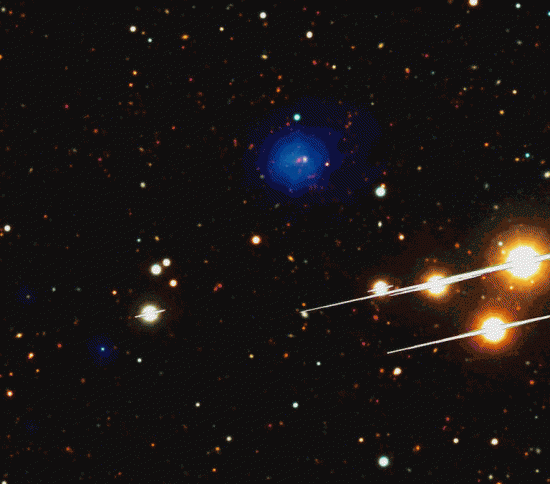Jan 18, 2013
A distant galaxy cluster is said to exhibit evidence for an unknown force. Not a single reference is made to the most powerful known force in the Universe: electricity.
The European Space Agency’s XMM Newton X-ray Telescope research team has found a grouping of galaxies containing more than 1000 times the mass of our own Milky Way in what they believe to be the most distant reaches of the Universe.
The speed of light is used as a benchmark for defining cosmological distance calculations: the shifting of Fraunhofer lines into the red end of observed spectra determines “recessional velocity”. As standard theories dictate, the faster an object recedes from Earth, the farther away it is and the older it is because the Big Bang explosion is said to have imparted an inertial impulse that is causing the Universe to expand. Based on those theoretical parameters, a faster recessional velocity means greater distance, which means an earlier time period.
According to Georg Lamar and his colleagues from the Astrophysikalisches Institut in Potsdam, massive galaxy clusters with such high redshift are rare when they shine so brightly at X-ray wavelengths. As the ESA press release states, the presence of “hot gas” encompassing the cluster with temperatures of 100 million Kelvin makes J083026+524133 the most energetic X-ray source at z > = 1 redshift – 100 times brighter than any other galaxy cluster at that distance.
Such a massive cluster with a 7.7 billion year age estimate is thought to confirm the existence of dark energy because dark energy causes acceleration in the expansion of the Universe. That acceleration makes it more difficult for massive clusters like J083026+524133 to hold together in more recent times because the dark energy expansion wants to tear them apart.
Astronomers made this disconcerting find ten years ago, that the Universe is expanding faster today than it did in the past. In order to accommodate anomalous redshift observations the existence of a force that exerts negative pressure on gravitational fields was proposed and later called “dark energy” because it cannot be detected with any instrument.
Enzo Brachini from the European Organization for Astronomical Research in the Southern Hemisphere (ESO) wrote: “This implies that one of two very different possibilities must hold true. Either the Universe is filled with a mysterious dark energy which produces a repulsive force that fights the gravitational brake from all the matter present in the Universe, or, our current theory of gravitation is not correct and needs to be modified, for example by adding extra dimensions to space.”
Presumptions are difficult to overcome. The inability of conventional researchers to understand several factors hampers their ability to grasp the fundamental nature of the cosmos. The quoted comments are a perfect example of the absurd conclusions that can be drawn when electricity in space is ignored.
Two of the most pressing issues in the modern approach to understanding the Universe are the adherence to redshift as the only tool for estimating distances and ages of stars and galaxies, and a lack of knowledge when it comes to electricity.
First, in order to advance the catalogue of knowledge it often requires one’s reputation and livelihood be placed on the block and the axe allowed to fall where it may. It takes real courage to buck the system and stand on one’s convictions despite antagonism. Such is the case with Halton Arp, one of the grand masters in the field of astronomical research.
Dr. Arp earned his place at the top of his field through years of research and many lonely hours on cold mountain peaks documenting far-flung celestial objects. As his galactic compendium grew, he noticed that there was something wrong with conventional time-speed-distance calculations – he found objects with higher redshift values in front of objects with lower redshift. Surely, such a conundrum should have immediately called into question the very nature of that “cosmological constant”.
If redshift is not an indicator of distance, J083026+524133 may not be so far away and therefore not so massive or bright. As Arp and his colleagues have repeatedly shown, taking in a wider field of view often reveals similar objects on the opposite side of a nearby active galaxy. Many of these high-redshift pairs are connected across the galaxy with a bridge of radiating material. Theories of an expanding Universe, dark matter, and dark energy depend on the XMM Newton’s (and other observatories) extremely narrow field of view and how the data is selected.
Second, by referring to material with a temperature of 100 million Kelvin as “hot gas” astrophysicists are highlighting their complete ignorance of plasma and its behavior. No atom can remain intact at such temperatures – electrons are stripped from the nuclei and powerful electrical fields develop. The gaseous matter becomes plasma, capable of conducting electricity and forming double layers.
In 1986, Hannes Alfvén, in a NASA-sponsored conference on double layers in astrophysics, said:
“Double layers in space should be classified as a new type of celestial object (one example is the double radio sources). It is tentatively suggested that x-ray and gamma ray bursts may be due to exploding double layers. In solar flares, [double layers] with voltages of 10^9 volts or even more may occur, and in galactic phenomena, we may have voltages that are several orders of magnitude larger.”
Plasma is the first state of matter and makes up more than 99.99% of all that we observe in the Universe. Cosmological redshift has been shown to be a property of matter and not one of velocity. It is far past time that scientists actually look at what they see with critical eyes.
Stephen Smith













